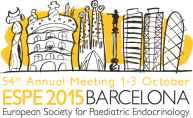
54th Annual ESPE
Barcelona,
Spain
01 Oct 2015 - 03 Oct 2015
Poster Category 3
Turner
hrp0084p3-1233 | Turner | ESPE2015
Growth Curves for Turkish Girls with Turner Syndrome: Results of the Turkish Turner Syndrome Study Group
Darendeliler Feyza , Bereket Abdullah , Bas Firdevs , Bundak Ruveyde , Sari Erkan , Aydin Banu K , Darcan Sukran , Dundar Bumin , Buyukinan Muammer , Kara Cengiz , Mazicioglu Mumtaz M , Adal Erdal , Akinci Aysehan , Atabek Mehmet E , Demirel Fatma , Celik Nurullah , Ozkan Behzat , Simsek Enver , Cinaz Peyami , Group Turner Syndrome Study
hrp0084p3-1234 | Turner | ESPE2015
Cardiovascular Assessment in Turner Syndrome: Current Practice in the United Kingdom
Mason A , Smyth A , Ahmed S F , Wong S C
hrp0084p3-1235 | Turner | ESPE2015
Turner Syndrome in Iceland 1968–2012: Congenital Anomalies and Clinical Outcomes
Sigmarsdottir Arndis A , Johannsson Johann H , Sigurjonsdottir Helga A , Thorsson Arni V
hrp0084p3-1236 | Turner | ESPE2015
A Comparison of Efficacies between rhGH and rhGH Combined with Stanozolol Therapies in Growth of the Girls with Turner Syndrome
Li Dan , Chen Hongshan , Du Minlian , Li Yanhong , Chen Qiuli , Ma Huamei , Zhang Jun
hrp0084p3-1237 | Turner | ESPE2015
Clinical Features and Genetic Considerations of Turner Syndrome: A Review of Our Cases
Berrade Sara , Chueca Maria , Zarikian Sada , Mosquera Arantxa , Ulibarrena Noelia , Sola Alberto , Garcia Cristina , Oyarzabal Mirentxu
hrp0084p3-1238 | Turner | ESPE2015
Growth Characteristics of Patient with Turner Syndrome Different Age and Karyotypes by the Ukrainian National Register
Zelinska Nataliya , Shevchenko Irina , Globa Evgenia , Pogadaeva Nataliya
hrp0084p3-1239 | Turner | ESPE2015
Nationwide Study of Turner Syndrome in Ukraine
Zelinska Nataliya , Shevchenko Irina , Globa Evgenia , Pogadaeva Nataliya
hrp0084p3-1240 | Turner | ESPE2015
Patients with Turner’s Syndrome Should Have Ophthalmological Examination before Commencing Recombinant GH Treatment
Alsaffar Hussain , Thomason Eleanor , Blair Joanne , Didi Mohammed
hrp0084p3-1241 | Turner | ESPE2015
Renal Problems in Early Adult Patients with Turner Syndrome
Chung Woo Yeong , Oh Seung Hwan , Yu Dong Uk
hrp0084p3-1242 | Turner | ESPE2015
To Predict Ovarian Function is a Single Determination of AMH Useful in Patients with Turner Syndrome?
Piona Claudia Anita , Cavarzere Paolo , Gaudino Rossella , Ben Sarah Dal , Ramaroli Diego , Gelati Matteo , Guidi Gian Cesare , Salvagno Gian Luca , Antoniazzi Franco
hrp0084p3-1243 | Turner | ESPE2015
Anthropometric Findings from Birth to Adulthood in Turkish Girls with Turner Syndrome and Association with Karyotpye Distribution
Sari Erkan , Bereket Abdullah , Yesilkaya Ediz , Bas Firdevs , Bundak Ruveyde , Aydin Banu K , Darcan Sukran , Dundar Bumin , Buyukinan Muammer , Kara Cengiz , Adal Erdal , Akinci Aysehan , Atabek Mehmet E , Demirel Fatma , Celik Nurullah , Ozkan Behzat , Ozhan Bayram , Orbak Zerrin , Ercan Oya , Study Group Turner Syndrome
hrp0084p3-1244 | Turner | ESPE2015
GH Therapy in Turner Syndrome
Galesanu Corina , Loghin Andra Iulia , Ungureanu Didona , Galesanu Mihail Romeo
hrp0084p3-1245 | Turner | ESPE2015
A Rare Variant of Turner Syndrome: First Clinical Report from Kuwait
Mohamed Kholoud , Al-Abdulrazzaq Dalia
hrp0084p3-1246 | Turner | ESPE2015
Turner Syndrome with Breast Development: Case Report
Park Sung Won , Cho Sung Yoon , Kim Jinsup , Huh Rimm , Kim Su Jin , Jin Dong-kyu



